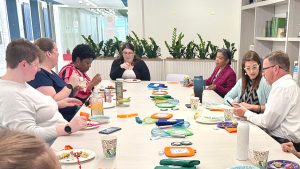The post Trade groups learn about the power of U.S. soybeans while touring Indiana appeared first on United Soybean Board.
Soybeans might be bought and sold on the Chicago Board of Trade, but farmers know they’re anything but impersonal numbers on a screen. Much like everyday consumers interested in where food comes from, international soybean buyers want to know the people behind the product. As in-person connections become possible again, your soy checkoff works with partners to showcase the quality, reliability and sustainability of soybeans grown in the United States.
In late May to early June, the U.S. Soybean Export Council and the Indiana Soybean Alliance hosted soybean importers from nine countries who visited farms, sampled cuisine featuring U.S. soybean oil and made connections across the supply chain. Stops included meetings with the Indiana Soybean Alliance, a tour of Purdue University, Corteva, Bunge and several Indiana farms. The face-to-face meeting is one way USSEC and the checkoff help make U.S. soybeans more attractive to global end users. The international visitors were some of the first to visit the U.S. after a 27-month hiatus due to the COVID-19 pandemic.
Tom Griffiths, a checkoff farmer-leader from Kendallville, Indiana, welcomed the group to his farm and provided insight into soybean production and marketing in the United States. Griffiths grows corn, hay, alfalfa and soybeans and manages a small feeder cattle herd. He is a first-generation farmer who farms with his wife, Kim, and son, Glen.
He told the group that, like many other farmers across the state, he had a tough time planting his soybean crop this season due to cold, wet weather that consumed much of the Midwest during the prime planting months.
Tom Griffiths, soy checkoff farmer-leader from Kendallville, Indiana
“We’ve been fighting the weather for most of the spring, but as you can see, the soybeans are starting to emerge,” Griffiths says while walking with the group through a field near his house.
The soybean seedlings were a draw as the visitors fanned out across the field, taking photos of the plants poking through the organic debris from the 2021 crop in his no-till field. Participants held harvested soybeans from the 2021 crop while comparing them to the early stages of the 2022 crop. The experience punctuated the checkoff’s power and international marketing’s impact.
“These trade missions are invaluable from the standpoint that they reaffirm to foreign buyers that when they buy soybeans from the United States, they’re buying from the country that’s got the most reliable and sustainable system in the world,” Griffiths says. “A lot of times, they’re not involved in agriculture and don’t know what happens on the farm. I would hope that when they return to their respective countries and sit down to buy soybeans, they remember coming to my farm and say, you know, I want to buy soybeans from Tom Griffiths. I want to buy U.S. Soy.”
Members of the group were included because of their connection to U.S. soybean oil and food uses in their native countries. USSEC builds relationships between global buyers and domestic producers to increase the value of U.S. soybeans and expand markets for U.S. soybeans.
“This is eye-opening and fantastic for these people,” Will McNair, USSEC stakeholder relations manager, says. “They are able to learn about innovations happening in the U.S., learn how farmers make their planting decisions, see how land-grant universities work and the innovations taking place in genetics and production agriculture.”
In this global economy, customers have demonstrated that they care about how soybeans are grown. With checkoff support, domestic trade missions help international buyers understand that U.S. soybeans are sustainable, reliable and high quality.
As Griffiths walked the trade group around his farm, he answered questions about his equipment, crop conditions and how he started farming in the area. Often the only interaction international buyers, scientists and industry representatives have with U.S. agriculture products is as prices on a spreadsheet. Until your checkoff gives them a chance to meet a farmer like Griffiths.
“The group was made up of some extremely high-level people, like the head of the oilseed processors association of India,” McNair says. “India is the world’s largest vegetable oil buyer and one of the most populous nations on Earth. And they are a huge target market for U.S. Soy products. The people we brought in from these different countries are directly responsible for the oil consumption of 1.5 billion to 2 billion people.”
Victor Carabalí, a tour participant from Colombia, appreciated the opportunity to tour the Griffiths farm and learn more about U.S. soybean oil production.
“It was interesting to learn about the crop production tools like herbicides, insecticides and fungicides used to grow crops,” he says. “I am a chemical engineer, so the biggest takeaway was learning how economics affects the supply for us. Indiana is a beautiful state, and I’m glad I had the opportunity to visit.”



